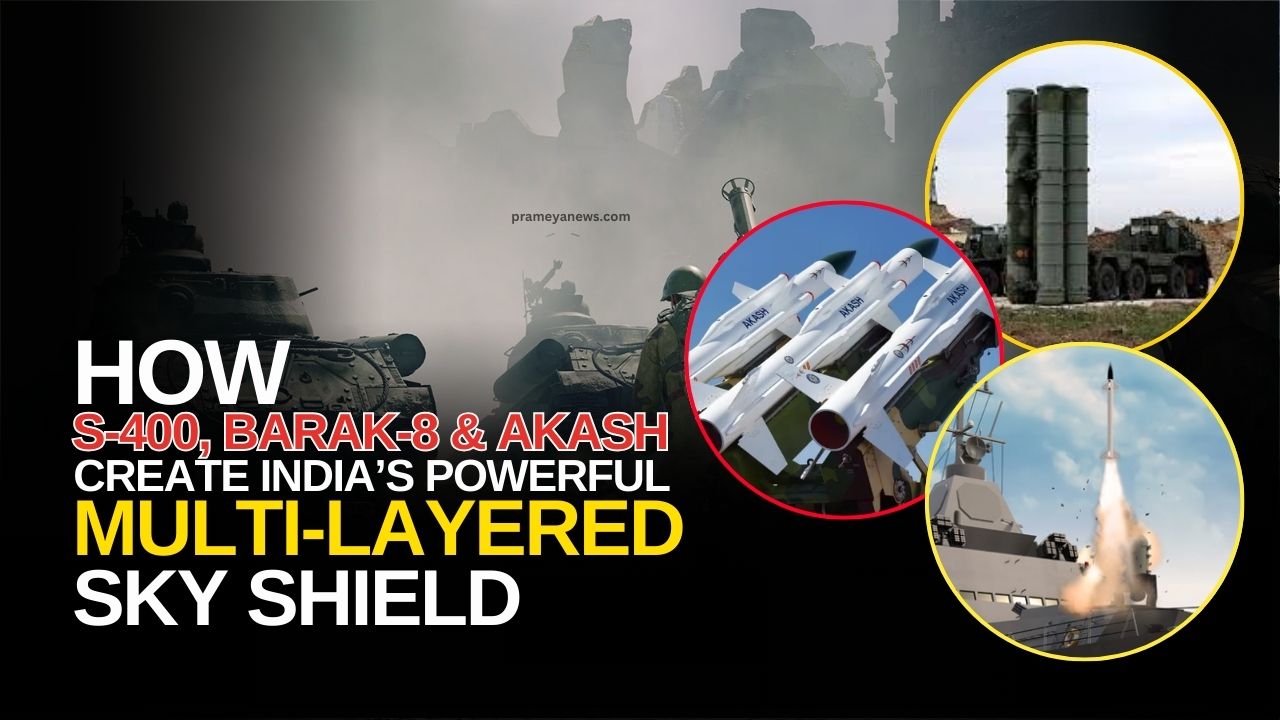India's Multi-Layered Air Defence Shield
Recent events, including the reported operational use of India's S-400 Triumf air defence system on the intervening night of May 7-8, 2025, to counter aerial threats from Pakistan, have brought the nation's sophisticated air defence capabilities into focus. A robust, multi-layered air defence is critical in the current geopolitical landscape. India had strategically invested in acquiring and developing a formidable air defence systems. These are the long-range S-400 'Sudarshan Chakra', the Indo-Israeli Barak-8, and the indigenous Akash missile system.
The S-400 Triumf: The Long-Range 'Sudarshan Chakra'
The S-400 Triumf, acquired from Russia, stands as one of the world's most advanced long-range surface-to-air missile (SAM) systems. Nicknamed 'Sudarshan Chakra' in India, invoking the mythological divine weapon known for its precision and power, the S-400 is engineered to counter a wide spectrum of aerial threats. These include enemy aircraft, unmanned aerial vehicles (UAVs), cruise missiles, and even ballistic missiles. Its advanced capabilities allow for seamless integration into India’s broader multi-layered air defence command and control structure.
Key operational features of the S-400:
- Multi-Target Engagement: It can simultaneously track and engage up to 36 distinct targets, leveraging its sophisticated radar network.
- Extended Interception Range: Its longest-range missiles are capable of intercepting threats up to 400 kilometers away, providing a vast area of operational coverage.
- Rapid Deployment: The system is mounted on mobile launchers, enabling it to be positioned and activated within approximately five minutes, facilitating dynamic responses to evolving battlefield scenarios.
- High-Altitude Reach: It can effectively neutralize targets at altitudes ranging from near ground level up to 30 kilometers, including challenging targets like stealth aircraft and hypersonic threats.
- Speed and Precision: The S-400 is capable of intercepting incoming targets moving at speeds of up to 4.8 kilometers per second, offering a critical advantage against fast-moving missile or aircraft attacks.
Barak-8: Indo-Israeli Medium-Range Prowess
Complementing the S-400's long-range umbrella is the Barak-8 SAM system, a product of joint development between India (DRDO) and Israel (IAI). This system plays a crucial complementary role, particularly excelling in naval air defence and medium-range land-based engagements.
Distinctive features of the Barak-8 system include:
- 360-Degree Coverage: Utilizing advanced multi-mission radar and secure two-way data links, the Barak-8 can track and engage multiple aerial targets concurrently, including UAVs, helicopters, fixed-wing aircraft, anti-ship missiles, ballistic missiles, and cruise missiles.
- Propulsion and Agility: Its solid-propellant rocket motor and integrated advanced avionics provide high speed, maneuverability, and adaptability in diverse combat conditions.
- All-Weather Capability: The system is designed for reliable precision engagement day or night, and in adverse weather conditions.
- Variant Flexibility: It is available in three primary variants: the Barak-8 AMD/LRSAM for naval air defence; the MRSAM, a land-based medium-range version with mobile launchers and a dedicated radar-command network; and the Barak MX, a modular system adaptable for both naval and land missions.
The standard Barak-8 missile offers an engagement range of up to 100 kilometers, while an enhanced Barak-8ER (Extended Range) variant pushes this interception envelope out to 150 kilometers, providing India with a vital layer of medium-range air protection. The system's efficacy relies on integrated surveillance and guidance radars for highly precise target interception.
Akash Missile System: Indigenous Short-to-Medium Range Defence
The Akash missile system represents a significant achievement in India's indigenous defence manufacturing capabilities. It is a short- to medium-range mobile SAM platform designed to protect Indian military forces and critical strategic assets from a variety of aerial attacks. Highly mobile and versatile, the Akash system can defend static installations, semi-mobile formations, and moving military columns against threats such as enemy aircraft, drones, and helicopters.
Key attributes of the Akash missile system are:
- Engagement Envelope: It can engage aerial targets at ranges from 4.5 kilometers out to 25 kilometers, and at altitudes varying from 100 meters up to 20 kilometers.
- High Mobility: The entire system is mounted on mobile platforms, facilitating easy transportation across varied terrain and enabling rapid deployment by road or rail.
- Firepower: Each Akash launcher is armed with three ready-to-fire missiles. Each missile is approximately 5.87 meters long, weighs around 710 kilograms, and carries a 60-kilogram high-explosive pre-fragmented warhead.
- Multi-Target Capability: The system is capable of tracking and neutralizing multiple aerial threats simultaneously, utilizing real-time data from multiple sensors and guided by phased array radar.
- Automation: It features an automatic detection-to-kill operational cycle, ensuring rapid target acquisition, identification, and engagement sequences.
- Electronic Warfare Resilience: The Akash is built with Electronic Counter-Counter Measures (ECCM) to resist enemy jamming and other electronic warfare tactics, enhancing its survivability and effectiveness.
- Network Centricity: Designed with an open-system architecture, Akash ensures interoperability with India's current and future integrated air defence networks.
The Akash system’s fire-and-forget capability, combined with its inherent mobility and precision, makes it a potent and valuable tool within India’s layered air defence grid. It effectively complements the longer-range capabilities of systems like the S-400 Triumf and Barak-8, contributing to a comprehensive, multi-tier defensive shield against incoming aerial threats.

